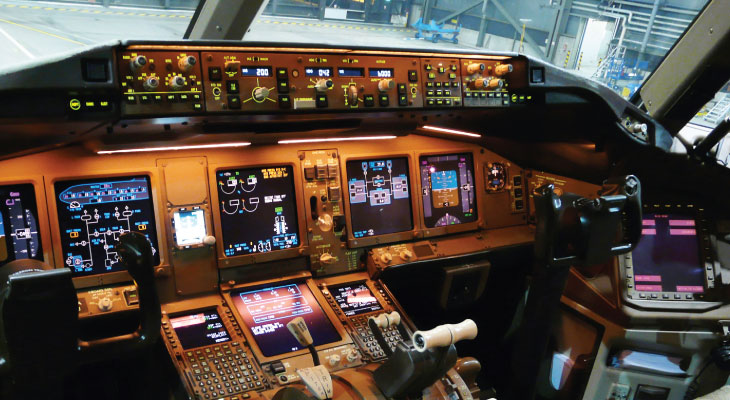How Aircraft Systems Depend on Acme Thread Actuators

How Aircraft Depend on Acme Thread Actuators
Developed more than 100 years ago, the acme thread form remains a reliable and practical design. Actuators driven by screws using this thread have become a staple for providing linear actuation and motion control in today’s modern aircraft for non-flight critical applications. Linear actuators are also in the docking and maintenance equipment used to service airline fleets.
The acme thread form is the original trapezoidal screw thread that was developed back in the late 1800s. It has a 29° thread angle with a thread height half of the pitch, the distance between a point on one thread, and a corresponding point on the following thread parallel to the axis. The apex and valley of the thread are flat. Since the tooth shape of an acme thread has a broader base, it is more vital than a similarly sized square thread. Thus, a linear actuator using this thread can carry larger loads, such as those required for aircraft and airplane maintenance actuation systems.
Aircraft Actuator Applications
The acme thread form is utilized in some of the electro-mechanical actuators and is qualified for use in many non-flight critical linear motion control applications. The design’s high reliability, ability to move large loads and dependable performance history make this thread ideal for aircraft-related actuation systems. When paired with high-quality, aerospace-specific motors, actuators based on this thread form can be configured and weight-optimized to drive a variety of aircraft-related linear motion control systems, including:
- Auxiliary Power Unit (APU) Inlet Door Actuators
- Ram Air Door Actuators (which include variable geometry inlet doors, turbofans, and variable exhaust louvers on some aircraft for controlling ram airflow)
- Utility Door Actuators
- Air Bypass Door Actuators
- Cargo Door Actuators
- Crew Escape and Emergency Door Actuators
- Seat Adjustment Actuators
- Canopy Actuators
- Silencer Actuators
- Airflow Control Actuators
- Nozzle Actuators
- Landing Gear Uplock Actuators
Actuators in Aircraft Docking and Maintenance Systems
Commercial airline companies perform routine and annual maintenance and overhauls of every plane in their fleet to keep passenger jets functioning safely. While routine maintenance is often performed in a hangar or on the tarmac, yearly overhauls require sophisticated equipment to provide maintenance workers with safe, ready access to every part of the plane, from the nose, fuselage, and tail to the landing gear, stabilizers, and wingtips.
This access is typically provided through docking systems and maintenance platforms that require a range of linear motion control systems. Actuators utilizing Acme Screws can lift and lower maintenance technicians, aircraft components, and supplies using adjustable stands, sliding decks, and push boards. Because the loads created by aircraft maintenance docking systems can exceed 100,000 pounds, linear actuators must be solid and reliable for safe operation, making Acme Screws an excellent option.
Use Helix Linear Actuators in Your Aircraft Application
Contact Helix Linear Technologies for your aircraft-related linear actuator needs. Helix supplies a complete line of Acme Screws that have proven to be vital components in aircraft and aircraft docking and maintenance systems. With Helix Acme Screws, you will find the reliability and performance combination critical to safe air travel and aircraft maintenance activities.
To learn more about how Helix Acme Screws can dependably meet your aircraft, docking, and maintenance actuator needs, consult with an aerospace application engineer today.


